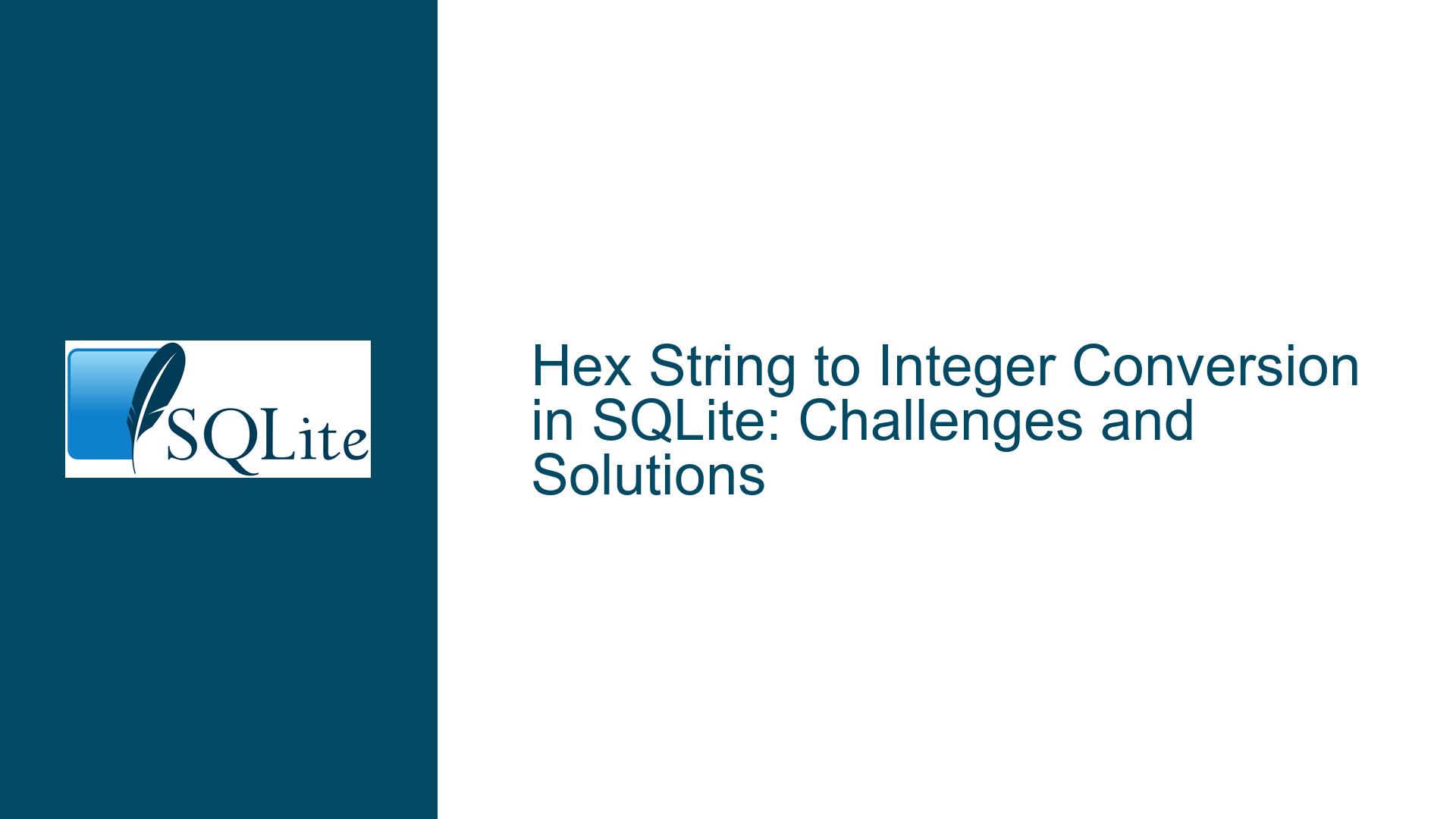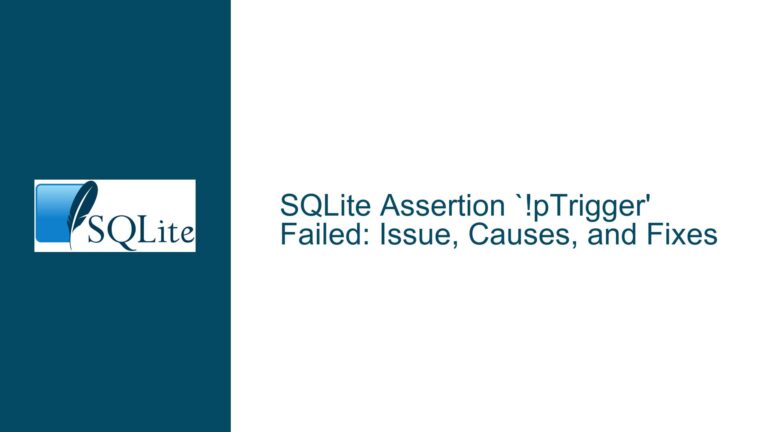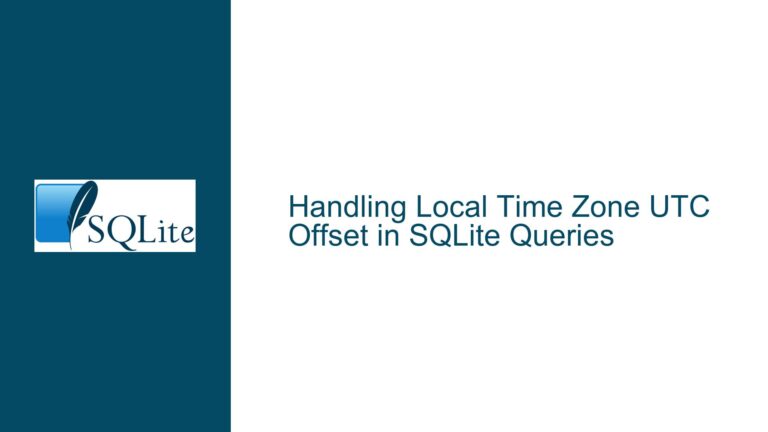Hex String to Integer Conversion in SQLite: Challenges and Solutions
SQLite’s Implicit vs. Explicit Hex String Conversion Behavior
SQLite exhibits a nuanced behavior when handling hexadecimal values, particularly when distinguishing between implicit and explicit conversions. This behavior is central to the issue at hand. When a hexadecimal value is provided directly as a literal (e.g., 0xa1), SQLite implicitly converts it to its integer equivalent. For example, the query SELECT 0xa1; correctly returns 161. This implicit conversion is seamless and works as expected because SQLite recognizes the literal as a hexadecimal number.
However, the situation becomes more complex when dealing with hexadecimal values stored as strings. Consider the following query:
WITH cte(xx) AS (VALUES('0xa1 Desc'))
SELECT substr(xx,1,5) AS V1, cast(substr(xx,1,5) AS Integer) AS V2 FROM cte;
Here, the substring '0xa1' is extracted from the string '0xa1 Desc'. Despite its appearance, SQLite treats '0xa1' as a plain string rather than a hexadecimal number. Consequently, attempting to cast it to an integer using CAST() results in 0. This discrepancy arises because SQLite’s CAST() function does not inherently recognize or interpret hexadecimal strings. Instead, it processes the string character by character, stopping at the first non-numeric character (in this case, x), and returns 0.
This inconsistency between implicit and explicit conversions is a key challenge. While SQLite can handle hexadecimal literals effortlessly, it lacks built-in mechanisms to interpret hexadecimal strings in the same way. This limitation necessitates alternative approaches to achieve the desired conversion.
String Interpretation and SQLite’s Casting Limitations
The core issue lies in SQLite’s handling of string-to-integer conversions, particularly when the string represents a hexadecimal value. When a string like '0xa1' is cast to an integer, SQLite does not interpret the 0x prefix as an indicator of a hexadecimal value. Instead, it processes the string sequentially, stopping at the first non-numeric character. In the case of '0xa1', the presence of x causes the conversion to halt, resulting in 0.
This behavior is consistent with SQLite’s design philosophy, which prioritizes simplicity and lightweight operation. Unlike some other databases, SQLite does not include specialized functions for hexadecimal conversion out of the box. Functions like CAST() and unhex() are not equipped to handle hexadecimal strings in the manner one might expect. For instance, the unhex() function is designed for converting hexadecimal strings to binary data (BLOBs), not integers. Attempting to use unhex() for integer conversion, as shown below, yields NULL:
SELECT unhex('0xa1') AS 'NULL';
SELECT unhex('42') AS 'B';
SELECT CAST(unhex('42') AS INT) AS 'also NULL';
SELECT CAST(unhex('0xa1') AS INT) AS 'also NULL';
These results underscore the limitations of SQLite’s native functions in handling hexadecimal strings. The absence of a direct conversion mechanism means that users must resort to alternative methods, such as manual arithmetic operations or user-defined functions, to achieve the desired outcome.
Implementing Manual Hex-to-Integer Conversion in SQLite
Given SQLite’s limitations, one effective approach is to implement a manual conversion process using SQL’s arithmetic and string manipulation capabilities. This method involves extracting the hexadecimal digits from the string, converting each digit to its decimal equivalent, and then combining these values to produce the final integer.
Consider the following query, which demonstrates this approach:
WITH cte(xx) AS (VALUES ('0xa1 Desc'))
SELECT
substr(xx, 1, 5) AS V1,
(
(instr('0123456789abcdef', lower(substr(xx, 3, 1))) - 1) * 16 +
(instr('0123456789abcdef', lower(substr(xx, 4, 1))) - 1)
) AS V2
FROM cte;
Explanation of the Query
Extracting the Hex Value: The
substr(xx, 1, 5)function retrieves the substring'0xa1'from the original string'0xa1 Desc'.Hex to Decimal Conversion:
- The
instr('0123456789abcdef', lower(substr(xx, 3, 1))) - 1expression identifies the position of the first hexadecimal digit (a) in the string'0123456789abcdef'. Sinceacorresponds to10in decimal, this expression evaluates to10. - Similarly,
instr('0123456789abcdef', lower(substr(xx, 4, 1))) - 1identifies the position of the second hexadecimal digit (1), which corresponds to1in decimal.
- The
Combining the Values: The formula
(A * 16) + Bcomputes the final integer value. In this case,(10 * 16) + 1 = 161.
Expected Output
| V1 | V2 |
|---|---|
| 0xa1 | 161 |
This method effectively converts the hexadecimal string '0xa1' to its integer equivalent 161 using pure SQLite, without requiring additional functions or extensions.
Limitations and Considerations
While this approach works for the specific case of '0xa1', it is important to note its limitations. The query assumes a fixed format for the hexadecimal string (i.e., 0x followed by exactly two hexadecimal digits). If the input format varies, the query would need to be adjusted accordingly. Additionally, this method becomes increasingly complex for longer hexadecimal strings, as each pair of digits must be processed individually.
For more robust and flexible solutions, especially in scenarios involving variable-length hexadecimal strings or frequent conversions, consider implementing a user-defined function (UDF) in SQLite. UDFs allow for custom logic to be embedded directly into SQL queries, providing greater flexibility and reusability. However, this approach requires programming in a language supported by SQLite’s extension mechanism, such as C or Python.
Alternative: Using SQLite Parameters for Indirect Conversion
An interesting observation from the discussion is SQLite’s handling of hexadecimal values when passed as parameters. For example:
sqlite> .param init
sqlite> .param set @dd '0x1f41'
sqlite> select @dd; -- string is seen as a hex value
@dd
----
8001
In this case, the parameter @dd is interpreted as a hexadecimal literal, resulting in the correct integer value 8001. This behavior is specific to the SQLite CLI and does not extend to standard SQL queries. However, it highlights an alternative approach for scenarios where hexadecimal values can be passed as parameters rather than hardcoded strings.
Conclusion
Converting hexadecimal strings to integers in SQLite requires a nuanced understanding of the database’s handling of literals and strings. While SQLite excels at implicit conversions for hexadecimal literals, it lacks built-in support for explicit conversions of hexadecimal strings. By leveraging SQL’s string manipulation and arithmetic capabilities, users can implement manual conversion methods to achieve the desired results. For more complex or frequent conversions, user-defined functions offer a powerful and flexible solution. Understanding these techniques empowers developers to overcome SQLite’s limitations and effectively manage hexadecimal data within their applications.






